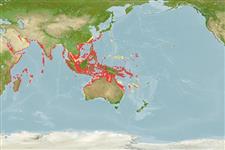板鰓亜鋼(サメとエイ類) (sharks and rays) >
Myliobatiformes (Stingrays) >
Dasyatidae (Stingrays) > Hypolophinae
Etymology: Pastinachus: Latin, pastinaca = a sting ray (Ref. 45335).
Issue
This species which is similar to Pastinachus ater, an Indo-West Pacific species, is found only in Northwestern Indian Ocean. Erroneous information will be deleted.
Environment: milieu / climate zone / depth range / distribution range
生態学
海; 新鮮な水; 汽水性の 関連する礁; 両側回遊性 (Ref. 51243); 深さの範囲 0 - 60 m (Ref. 6871). Tropical
Northwestern Indian Ocean: Red Sea to Pakistan.
Length at first maturity / サイズ / 重さ / 年齢
Maturity: Lm 98.0, range 96 - 100 cm
Max length : 183 cm WD オス/雌雄の選別がない; (Ref. 37816); common length : 65.0 cm WD オス/雌雄の選別がない; (Ref. 27550)
背面の脊椎 (合計) : 0. A large, plain, dark stingray with an angular snout and pectoral disc; tail long and broad-based, less than twice body length, and with no upper caudal finfold but with high lower caudal finfold- 2 to 3 times depth of tail but not reaching tail tip; no large thorns; 1 or 2 long stings on tail, further behind tail base than in most stingrays; unique hexagonal, high-crowned teeth (Ref. 5578). Dark brown or black dorsally without conspicuous markings, white ventrally (Ref. 5578). Tail black (Ref. 3263).
Found in lagoons, reef flats, and reef faces (Ref. 12951). Also in rivers far from the sea (Ref. 5578). Feeds on bony fishes, worms, shrimp, and crabs (Ref. 12951). Ovoviviparous (Ref. 50449). Adults are sometimes accompanied by remoras or members of the trevally family (Ref. 6871). Size at birth about 18 cm WD or larger (Ref. 6871). Flesh utilized as food and skin used for polishing wood (Ref. 4832). Possibly caught by sports anglers (Ref. 5578). Recently there is a targeted fishery on this species for its skin, which is used as 'shagreen' in fashion accessories, from wallets to fancy pens; as a result, the species is in danger of disappearance (IHT 26.11.2005, p.5). Maximum length about 300 cm TL (Ref. 30573).
Life cycle and mating behavior
Maturities | 繁殖 | Spawnings | Egg(s) | Fecundities | 幼生
Exhibit ovoviparity (aplacental viviparity), with embryos feeding initially on yolk, then receiving additional nourishment from the mother by indirect absorption of uterine fluid enriched with mucus, fat or protein through specialised structures (Ref. 50449). Distinct pairing with embrace (Ref. 205). Size at birth ~ 18 cm WD (Ref.58048).
Last, P.R. and J.D. Stevens, 1994. Sharks and rays of Australia. CSIRO, Australia. 513 p. (Ref. 6871)
Human uses
水産業: 少数商業の; 水族館・水槽: 商業
用具
特記事項
XMLをダウンロードして下さい
インターネットの情報源
Estimates based on models
Preferred temperature (Ref.
123201): 24.7 - 29.1, mean 28.2 °C (based on 1694 cells).
Phylogenetic diversity index (Ref.
82804): PD
50 = 0.5312 [Uniqueness, from 0.5 = low to 2.0 = high].
Bayesian length-weight: a=0.01000 (0.00244 - 0.04107), b=3.04 (2.81 - 3.27), in cm total length, based on all LWR estimates for this body shape (Ref.
93245).
栄養段階 (Ref.
69278): 3.7 ±0.60 se; based on food items.
回復力 (Ref.
120179): 非常に低い, 14年以上の倍増期間の最小個体群 (Assuming Fec<10).
Fishing Vulnerability (Ref.
59153): Very high vulnerability (90 of 100).
Nutrients (Ref.
124155): Calcium = 8.51 [1.64, 34.97] mg/100g; Iron = 0.364 [0.085, 0.964] mg/100g; Protein = 22.9 [19.9, 26.0] %; Omega3 = 0.102 [0.029, 0.298] g/100g; Selenium = 31.4 [9.0, 84.2] μg/100g; VitaminA = 33 [12, 99] μg/100g; Zinc = 0.851 [0.416, 1.706] mg/100g (wet weight);
